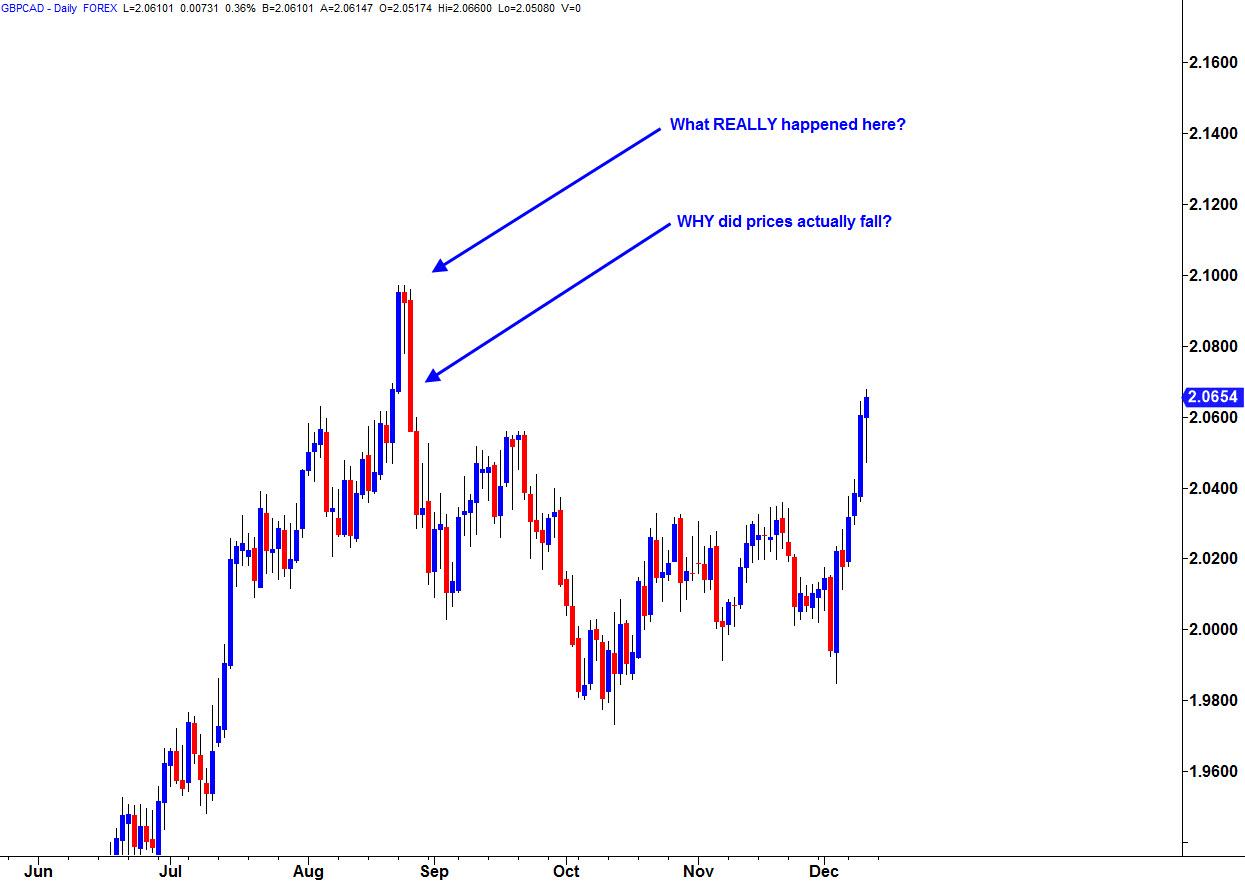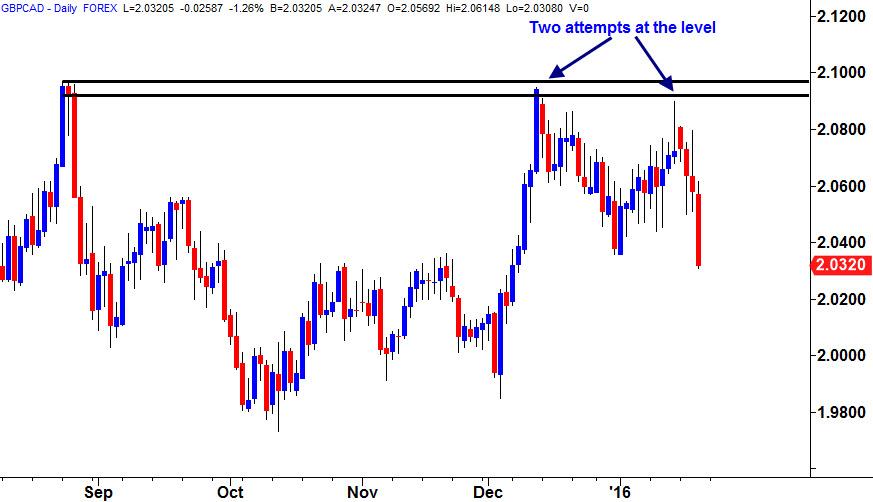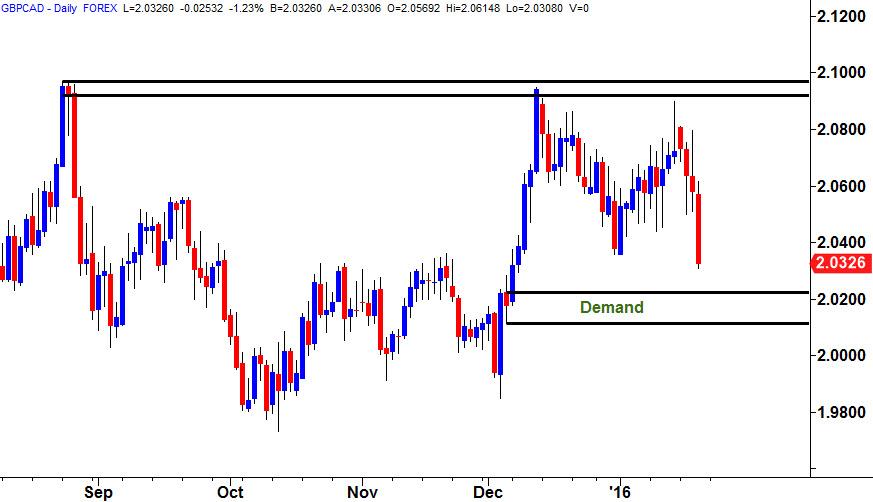![]()
Thanks for all of your positive comments and feedback from my article I wrote 2 weeks ago that reviewed our Core Strategy and why we teach our students to buy and sell like the biggest banks and institutions at key levels of Supply and Demand. In that piece, I explored a selling setup on the GBPCAD currency pair and why we would have chosen such a level for a trading opportunity. If you missed it, the level in question was this:
We explored exactly what happened at the level, explaining that the reason we would be interested in selling at the level of supply was for 2 very specific reasons:
There was clearly an imbalance between the orders to buy and to sell, with the sell orders being vastly greater than the orders to buy. These sellers didn’t get all of their orders filled resulting in Supply being greater than Demand and the dramatic fall in prices.
The level was very likely created by major banks and institutions, simply because they have far greater buying power and larger order size than those of the retail crowd, so we want to be entering the market when they do.
As we saw, the price did return to the level and dropped a decent way down. Here is an updated snapshot of the trade:
Now, it is always nice to show people a trade setup which works, but in reality there are also plenty of them that fail too. Does this really matter if we win big and lose small though? Of course not. Remember that the task of a trader is to time the markets for entry with a high degree of accuracy, getting into trades when the risk is low and the reward is high. Looking at the above opportunity, we can clearly see that the size of the risk as defined by the size of the zone is very small, yet the drop away from the zone was significant enough to generate a healthy reward. This, in turn, gives us plenty of chances to lose trades and still maintain a strong level of profit.
When we understand this dynamic of risk to reward ratios clearly, it removes the pressure of attempting to “know” what is coming next. I say this because one of the many emails I got in response to my last article was from a gentleman who saw the level on the GBPCAD and asked me how I knew that the trade was going to work. He explained to me that there was no reason for the trade to fall from that area and just because the market respected the zone once before, there was no reason for it to do so again. I think he made a fair point but here is the thing: the minute we begin to think about the consequences of a trade before we actually take the trade itself, is when we begin to run into trouble. We now have a Demand zone approaching on the same GBPCAD pair and the rules tell us this is a low risk chance to buy. It may or may not work, but the only way to find out is to take the trade as we find it:
The issue is with the thinking. Do you really think that the major banks and institutions know when something is going to happen? Do they have a secret that they are not telling us about? Is there a trading crystal ball in existence somewhere? I faced the facts many years ago and realized that nobody knows the outcome of a trade before it happens and nobody ever will. In fact, it is this element of the unknown which allows some to make good money from the markets and others to fail repeatedly. When a major bank sees an opportunity to buy or sell with low risk and high reward, do you really think that they worry about the trade not working? Why would they? It’s not their money after all, is it? In fact, I would go so far as to say that they would be more concerned about not taking the trade and it then going on to work. It hurts far more to lose out on a large profit than it does to endure a small loss.
To anyone out there thinking there is a magic trick to the markets, know this: the trick is to not get into your own head. Trading is as much about the strategy you use as it is about actually ensuring your mental game is strong enough to implement this strategy without question, regardless of what you think. After all, as I said before, nobody knows what’s going to happen next. It’s more important to stay consistent enough to do what you need to do on a regular basis without worrying about what may or may not happen before it actually does. I hope this was helpful.
Note: All information on this page is subject to change. The use of this website constitutes acceptance of our user agreement. Please read our privacy policy and legal disclaimer. Opinions expressed at FXstreet.com are those of the individual authors and do not necessarily represent the opinion of FXstreet.com or its management. Risk Disclosure: Trading foreign exchange on margin carries a high level of risk, and may not be suitable for all investors. The high degree of leverage can work against you as well as for you. Before deciding to invest in foreign exchange you should carefully consider your investment objectives, level of experience, and risk appetite. The possibility exists that you could sustain a loss of some or all of your initial investment and therefore you should not invest money that you cannot afford to lose. You should be aware of all the risks associated with foreign exchange trading, and seek advice from an independent financial advisor if you have any doubts.
Editors’ Picks
EUR/USD edges lower toward 1.0700 post-US PCE

EUR/USD stays under modest bearish pressure but manages to hold above 1.0700 in the American session on Friday. The US Dollar (USD) gathers strength against its rivals after the stronger-than-forecast PCE inflation data, not allowing the pair to gain traction.
GBP/USD retreats to 1.2500 on renewed USD strength

GBP/USD lost its traction and turned negative on the day near 1.2500. Following the stronger-than-expected PCE inflation readings from the US, the USD stays resilient and makes it difficult for the pair to gather recovery momentum.
Gold struggles to hold above $2,350 following US inflation

Gold turned south and declined toward $2,340, erasing a large portion of its daily gains, as the USD benefited from PCE inflation data. The benchmark 10-year US yield, however, stays in negative territory and helps XAU/USD limit its losses.
Bitcoin Weekly Forecast: BTC’s next breakout could propel it to $80,000 Premium

Bitcoin’s recent price consolidation could be nearing its end as technical indicators and on-chain metrics suggest a potential upward breakout. However, this move would not be straightforward and could punish impatient investors.
Week ahead – Hawkish risk as Fed and NFP on tap, Eurozone data eyed too

Fed meets on Wednesday as US inflation stays elevated. Will Friday’s jobs report bring relief or more angst for the markets? Eurozone flash GDP and CPI numbers in focus for the Euro.
RECOMMENDED LESSONS
Making money in forex is easy if you know how the bankers trade!
Discover how to make money in forex is easy if you know how the bankers trade!
5 Forex News Events You Need To Know
In the fast moving world of currency markets, it is extremely important for new traders to know the list of important forex news...
Top 10 Chart Patterns Every Trader Should Know
Chart patterns are one of the most effective trading tools for a trader. They are pure price-action, and form on the basis of underlying buying and...
7 Ways to Avoid Forex Scams
The forex industry is recently seeing more and more scams. Here are 7 ways to avoid losing your money in such scams: Forex scams are becoming frequent. Michael Greenberg reports on luxurious expenses, including a submarine bought from the money taken from forex traders. Here’s another report of a forex fraud. So, how can we avoid falling in such forex scams?
What Are the 10 Fatal Mistakes Traders Make
Trading is exciting. Trading is hard. Trading is extremely hard. Some say that it takes more than 10,000 hours to master. Others believe that trading is the way to quick riches. They might be both wrong. What is important to know that no matter how experienced you are, mistakes will be part of the trading process.



